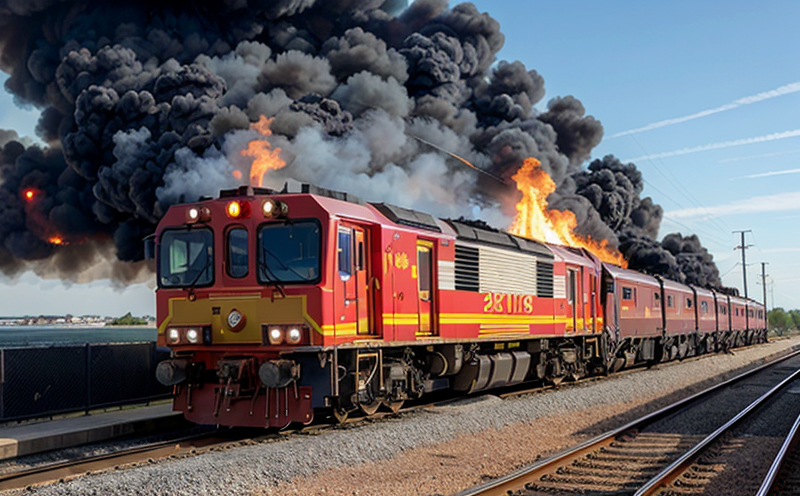Fire Performance Testing of Marine Ceiling Insulation
The fire performance testing of marine ceiling insulation is a critical aspect in ensuring the safety and compliance of ships and railway vehicles. This service plays a pivotal role in meeting stringent international standards, such as ISO 6941-7 for ceiling materials used on board ships, and EN 13501-1 & -2 for fire behavior testing of building products. The primary objective is to assess the ignition resistance, flame spread, smoke production, heat release rate, and structural integrity of insulation materials under controlled laboratory conditions.
The process begins with thorough specimen preparation, where samples are cut to standardized dimensions as per the relevant standards. This step ensures that all tests are conducted on representative pieces of material, thus providing accurate and reliable results. The testing apparatus used includes a calorimeter for heat release rate measurement and a smoke chamber for quantifying smoke production.
During the test, insulation samples are subjected to various ignition sources such as pilot flames or electric arcs, depending on the standard being followed. The duration of exposure is carefully controlled to simulate real-world conditions accurately. The parameters monitored during these tests include the time taken for ignition, flame spread rate, peak heat release rate, and the total smoke production.
Post-test analysis involves detailed examination of both qualitative and quantitative data collected throughout the testing process. This includes visual assessment of char depth, burn patterns, and structural damage along with numerical values derived from calorimetry and smoke chamber readings. The results are then compared against specified limits outlined in relevant fire safety standards to determine compliance.
The importance of this service cannot be overstated given its direct impact on passenger safety, regulatory compliance, and overall maritime safety initiatives. By providing robust evidence of a material's fire performance characteristics, it helps shipyards and railway manufacturers make informed decisions about their product designs, thereby enhancing the operational efficiency and safety standards aboard vessels.
In conclusion, fire performance testing of marine ceiling insulation is an indispensable tool in safeguarding lives at sea and ensuring adherence to global maritime regulations. It offers valuable insights into material behavior under extreme conditions, enabling continuous improvement in design and manufacturing practices.
Benefits
The benefits of undergoing fire performance testing for marine ceiling insulation are manifold:
- Promotes Compliance: Ensures adherence to international standards like ISO 6941-7, which is crucial for maintaining regulatory compliance.
- Enhances Safety: Provides critical data on a material's ability to resist ignition and spread of fire, thereby enhancing the overall safety of marine environments.
- Improves Quality: Identifies areas where improvements can be made in terms of flame resistance, smoke generation, and structural integrity.
- Supports Innovation: Encourages ongoing research and development by providing benchmark data against which new materials can be evaluated.
- Saves Costs: Early identification of non-compliant products helps avoid costly rework or scrapping processes later in the production cycle.
By leveraging these benefits, stakeholders involved in marine engineering and railway construction stand to gain significant advantages in terms of operational efficiency, enhanced safety measures, and cost-effectiveness.
Industry Applications
| Application Area | Description |
|---|---|
| Marine Ships | Testing ensures that ceiling insulation materials meet the stringent fire safety requirements set out in ISO 6941-7. |
| Railway Vehicles | Compliance with EN 13501-2 is guaranteed, ensuring structural integrity and flame spread resistance of ceiling insulation. |
| Offshore Platforms | Materials used in offshore platforms are tested to ensure they meet the highest fire safety standards applicable. |
| Passenger Vessels | Insulation materials for passenger vessels must comply with relevant international standards, ensuring safe evacuation routes and areas. |
| Vehicular Cabins | Railway vehicle cabins require insulation that does not contribute to fire spread or smoke generation, enhancing passenger safety. |
The data provided in the table highlights specific applications where fire performance testing of marine ceiling insulation is particularly important. Each sector has unique challenges and requirements when it comes to ensuring fire safety, making this service indispensable for maintaining high standards across all relevant industries.
Quality and Reliability Assurance
The quality and reliability assurance process in fire performance testing of marine ceiling insulation involves several key steps:
Standardized Procedures: Adherence to internationally recognized standards ensures consistent and reliable results. These include ISO 6941-7 for marine applications and EN 13501-series for broader building products.
Thorough Specimen Preparation: Careful preparation of the test specimens is essential to ensure accurate representation of real-world scenarios. This involves precise cutting, conditioning, and handling according to specified guidelines.
Advanced Instrumentation: Utilization of state-of-the-art calorimeters and smoke chambers allows for comprehensive measurement of key fire performance parameters such as heat release rate and smoke density.
Comprehensive Data Analysis: Post-test analysis involves detailed examination of both visual observations and numerical data. This includes evaluating char depth, burn patterns, peak heat release rates, and total smoke production against established benchmarks.
Repeatable Results: The reliability of the testing process is verified through repeated trials under identical conditions to ensure consistent outcomes.
Certification and Reporting: Compliance certificates are issued based on successful completion of all tests. Detailed reports provide a comprehensive overview of test procedures, results, and recommendations for improvement if necessary.
The rigorous quality assurance measures in place guarantee that the testing process is both accurate and consistent, providing stakeholders with confidence in the reliability of the results obtained.





